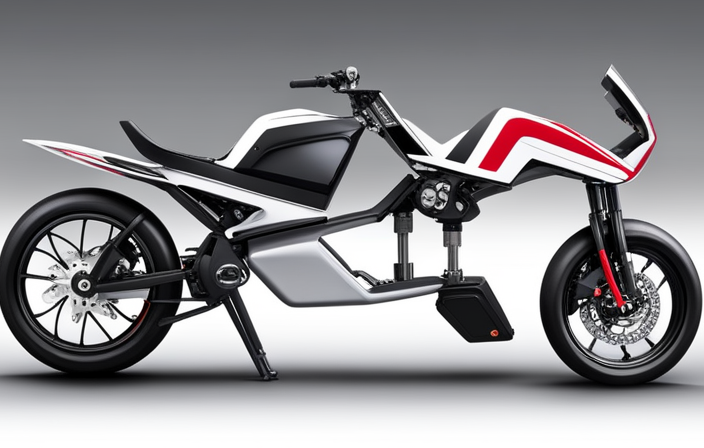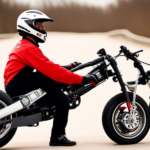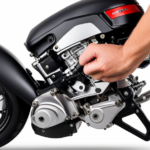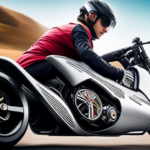Hey there, folks!
Ever wondered how to turn your electric pocket bike into a gas-powered beast? Well, look no further because I’ve got the step-by-step guide for you.
In this article, I’ll walk you through the process of converting your trusty electric ride into a gas-powered machine. From researching local regulations to gathering the necessary tools, we’ll cover it all.
So, buckle up and get ready to unleash the power of a gas engine on your pocket bike!
Key Takeaways
- Research and familiarize yourself with local regulations and requirements, including restrictions on engine size, speed limits, and noise levels.
- Evaluate the compatibility of your electric pocket bike for a gas engine conversion, considering the bike’s frame, suspension, brakes, and available space for installation.
- Gather the necessary tools and supplies for the gas engine conversion, and consider consulting a qualified mechanic if needed.
- Disconnect the electric components and remove the electric motor, inspecting it for wear or malfunction and finding replacement parts if necessary.
Research Local Regulations and Requirements
Before starting the conversion process, it’s important to research the local regulations and requirements for gas-powered pocket bikes. This step is crucial to ensure that you comply with all the necessary laws and guidelines.
Start by researching the specific regulations in your area regarding the use of gas-powered pocket bikes. Look for any restrictions on engine size, speed limits, or noise levels. It’s also essential to find out if any permits or licenses are required to operate a gas-powered pocket bike. Additionally, familiarize yourself with any safety requirements, such as wearing protective gear or installing safety features like headlights and taillights.
Once you have thoroughly researched the regulations, the next step is to find compatible parts for your electric pocket bike. Gas-powered pocket bikes require specific components, such as a gas tank, carburetor, exhaust system, and engine. Make sure to choose parts that are compatible with your bike’s model and make. Look for reputable suppliers or manufacturers that specialize in gas-powered pocket bike conversions. Consider consulting with experts or experienced hobbyists who can provide guidance on selecting the right parts for your bike.
Determine the Compatibility of Your Bike
Check if your bike is compatible with a gas conversion. Before diving into the process of converting your electric pocket bike into a gas-powered one, it is crucial to research compatibility and evaluate performance. Here are some steps to help you determine if your bike is suitable for a gas conversion:
-
Research Compatibility:
-
Check the specifications of your bike to see if it can handle the added weight and power of a gas engine.
-
Look for information on the bike’s frame, suspension, and brakes to ensure they can withstand the increased demands.
-
Consider the available space on the bike for mounting the gas engine and fuel tank.
-
Evaluate Performance:
-
Assess the current performance of your electric pocket bike, including its speed, acceleration, and range.
-
Research the performance capabilities of gas engines and compare them to your bike’s current capabilities.
-
Consider the expected benefits and drawbacks of converting to a gas engine, such as increased power but potentially higher maintenance requirements.
By thoroughly researching compatibility and evaluating performance, you can make an informed decision about converting your electric pocket bike into a gas-powered one.
In the next section, we will discuss how to choose the right gas engine conversion kit without compromising the bike’s performance.
Choose the Right Gas Engine Conversion Kit
To ensure you select the appropriate gas engine conversion kit, it’s important to consider factors such as compatibility and performance. Choosing the right conversion kit is crucial to successfully transforming your electric pocket bike into a gas-powered machine.
There are various options available in the market, so it’s important to do your research and find the kit that best suits your needs.
When selecting a conversion kit, one of the key factors to consider is compatibility. Make sure that the kit is designed specifically for your make and model of pocket bike. This will ensure a seamless installation process and prevent any compatibility issues down the line.
Another important aspect to consider is the performance of the conversion kit. Look for kits that offer increased power and speed, as well as reliable performance. Cost-effective conversion options are also worth exploring, as they provide a balance between quality and affordability.
Gather the Necessary Tools and Supplies
Once you’ve chosen the right gas engine conversion kit, gather all the tools and supplies needed for the installation process. Here’s a list of the essential items you’ll need:
- Wrench set – Make sure to have a variety of wrenches in different sizes to accommodate different bolts and nuts.
- Screwdriver set – A set of screwdrivers with various types and sizes will be necessary for removing and installing different components.
- Socket set – This will come in handy for loosening and tightening nuts and bolts that require a socket.
- Safety equipment – Don’t forget to wear safety goggles and gloves to protect yourself during the installation process.
Before starting the conversion, it is important to research gas engine options to ensure you select the most suitable one for your pocket bike. Additionally, finding a qualified mechanic who has experience with gas engine conversions can be valuable in assisting with the installation process.
Now that you have gathered all the necessary tools and supplies, it’s time to move on to the next step: disconnecting the electric components.
Disconnect the Electric Components
Before moving on to the next step, you’ll need to disconnect the electrical components from your current setup. This is an important step in the process of converting your electric pocket bike into a gas-powered one. By removing the electric components, you will make room for the new parts that will be installed later.
To help you understand which components to disconnect, I have created a table below:
| Component | Location |
|---|---|
| Battery | Under the seat |
| Controller | Near the handlebars |
| Motor | Near the rear wheel |
To begin, locate the battery under the seat of your pocket bike. Disconnect the wires connected to the battery terminals, ensuring that you label them for future reference.
Next, find the controller, which is usually located near the handlebars. Disconnect the wires connected to the controller, making sure to note their positions.
Finally, you’ll need to remove the electric motor near the rear wheel. This will be covered in the subsequent section.
Remove the Electric Motor
After disconnecting the electric components, the next step in converting my electric pocket bike into a gas-powered one is to remove the electric motor. This is a critical step as it involves detaching the heart of the bike’s propulsion system.
To begin, I must locate the electric motor, usually situated near the rear wheel. Once found, I will carefully disconnect the wiring harnesses and remove any bolts or screws securing the motor in place.
It is important to handle the motor with care to avoid damage. Once removed, I will inspect it for any signs of wear or malfunction. If the motor is in good condition, I could consider selling it to offset the cost of the gas engine. However, if the motor is faulty, finding a replacement might be necessary.
Finding replacement parts for the electric motor can be challenging, as they are not as readily available as gas engine components. Online marketplaces and specialized retailers may offer options, but thorough research is essential to ensure compatibility and quality.
With the electric motor removed, the stage is set for the next phase: installing the gas engine.
Install the Gas Engine
To install the gas engine, you will need to carefully position it in the designated area where the electric motor used to be. This is a crucial step in the gas engine conversion process, as it ensures proper alignment and functionality. The gas engine offers numerous benefits for a pocket bike, including increased power and longer range.
Once the gas engine is in place, you can begin connecting the fuel system.
Before connecting the fuel system, make sure you have all the necessary components. This includes the fuel tank, fuel lines, fuel filter, and carburetor. Carefully attach the fuel tank in a secure location on the pocket bike frame. Then, connect the fuel lines from the tank to the carburetor, ensuring a tight and leak-free connection. Install the fuel filter in between the fuel lines to prevent any debris from entering the carburetor.
Once the fuel system is connected, you can move on to the next step of the gas engine conversion process. This will allow the gas to flow smoothly into the engine, providing the necessary fuel for combustion.
With the gas engine now installed and the fuel system connected, your pocket bike is ready to roar to life with the power and efficiency of a gas-powered machine.
Connect the Fuel System
Once the fuel system is properly connected, you can ensure a smooth flow of gas to the engine. Here are some fuel system installation tips and troubleshooting common fuel system issues:
-
Check for leaks: Before connecting the fuel lines, inspect all connections for any signs of leakage. Use a fuel-safe sealant or tape to secure any loose fittings.
-
Proper hose routing: Ensure that the fuel lines are routed away from hot engine components or sharp edges that could cause damage. Use clamps or zip ties to secure the lines in place.
-
Fuel filter placement: Install a fuel filter in-line between the fuel tank and the carburetor. This will help prevent debris from entering the engine and causing damage.
-
Ventilation: Make sure the fuel tank has proper ventilation to prevent pressure build-up. This can be achieved by installing a vented fuel cap or a separate vent line.
-
Fuel pump installation: If your engine requires a fuel pump, follow the manufacturer’s instructions for proper installation. Ensure that the pump is securely mounted and that the fuel lines are connected correctly.
By following these fuel system installation tips, you can avoid common issues such as fuel leaks, improper fuel flow, and engine damage.
Once the fuel system is connected, you can proceed to adjust the carburetor and ignition timing for optimal performance.
Adjust the Carburetor and Ignition Timing
To ensure optimal performance, you should adjust the carburetor and ignition timing. These adjustments are crucial when converting an electric pocket bike into a gas-powered one. The carburetor controls the air-fuel mixture that enters the engine, while the ignition timing determines when the spark plug ignites the fuel. Properly adjusting these components will ensure that your converted pocket bike runs smoothly and efficiently.
When adjusting the carburetor, you need to find the right balance of air and fuel for combustion. This can be achieved by adjusting the idle screw, which controls the amount of fuel at idle, and the mixture screw, which determines the air-fuel ratio during acceleration. Troubleshooting common conversion issues, such as poor throttle response or excessive fuel consumption, can often be resolved by fine-tuning these carburetor adjustments.
Similarly, adjusting the ignition timing is crucial for the overall performance of your gas-powered pocket bike. The ignition timing determines when the spark plug fires, igniting the air-fuel mixture. Incorrect timing can result in poor engine performance, reduced power, and even engine damage. By adjusting the ignition timing, you can optimize the power output and efficiency of your converted pocket bike.
In summary, adjusting the carburetor and ignition timing is essential for the successful conversion of your electric pocket bike into a gas-powered one. These adjustments ensure the proper air-fuel mixture and ignition timing, resulting in optimal performance. Troubleshooting common conversion issues can often be resolved through these adjustments.
Now, let’s move on to the next step: installing the exhaust system.
Install the Exhaust System
Installing the exhaust system is crucial for the proper functioning of your converted electric pocket bike. The exhaust system plays a vital role in expelling the gases produced by the combustion process. It not only helps to improve the performance of the gas engine but also reduces noise pollution.
One of the benefits of gas powered pocket bikes is the increased power and speed compared to electric models. With the installation of a well-designed exhaust system, you can maximize the performance of your pocket bike.
However, installing an exhaust system on a pocket bike can present some common challenges. Firstly, you need to ensure that the exhaust system is compatible with your specific model. The dimensions, mounting points, and overall design should match the requirements of your bike. Additionally, you may need to make modifications to the frame or other components to accommodate the exhaust system properly.
Furthermore, proper alignment and sealing of the exhaust system are crucial to prevent any leaks or performance issues. You need to carefully follow the manufacturer’s instructions and use the appropriate gaskets and fasteners.
Once the exhaust system is installed, it’s time to move on to testing the gas engine conversion.
Test the Gas Engine Conversion
Now, you’ll need to ensure that the gas engine conversion is working properly by testing it. Here is the testing process along with some troubleshooting tips to help you along the way:
-
Start the engine: Turn the key to the ‘on’ position and slowly pull the starter cord to start the engine. Ensure that the engine starts smoothly and runs at a consistent idle speed.
-
Check for leaks: Carefully inspect the fuel lines, carburetor, and any connections for any signs of leaks. If you notice any leaks, promptly address them to prevent any further issues.
-
Test the throttle response: Gradually increase the throttle and observe how the engine responds. It should accelerate smoothly without any hesitations or stalling. If you experience any issues, check the throttle cable and adjust it if necessary.
-
Monitor engine temperature: Keep an eye on the engine temperature gauge or the temperature of the engine casing. The engine should not overheat during the testing process. If it does, check the cooling system and ensure it is functioning properly.
Once you have completed the testing process, you can make any necessary adjustments to optimize the performance of the gas engine conversion. This will ensure that your pocket bike is ready to hit the road with its newfound power.
Make Any Necessary Adjustments
Once you’ve completed the testing process, you’ll need to check for any necessary adjustments to optimize the performance of your gas engine conversion. This step is crucial to ensure that your pocket bike runs smoothly and efficiently. To assist you in this process, I have compiled a list of adjustment techniques and troubleshooting tips for your convenience.
| Potential Issue | Possible Cause | Adjustment Technique |
|---|---|---|
| Engine not starting | Fuel line blockage | Check and clean fuel line |
| Ignition system failure | Check spark plug and replace if necessary | |
| Carburetor issues | Adjust air-fuel mixture | |
| Battery problems | Check battery connections and charge if needed | |
| Engine running rough | Dirty air filter | Clean or replace air filter |
| Clogged fuel filter | Replace fuel filter | |
| Incorrect carburetor adjustment | Adjust carburetor settings | |
| Low compression | Check and repair engine components | |
| Excessive smoke | Incorrect oil mixture | Adjust oil-to-gas ratio |
| Damaged piston rings | Replace piston rings | |
| Faulty exhaust system | Inspect and repair exhaust system |
Ensure Proper Safety Measures
To ensure your safety during the adjustment process, always follow proper safety measures. When working on your electric pocket bike, it is important to take the necessary precautions to protect yourself from potential hazards. Here are three key safety measures to keep in mind:
-
Always wear appropriate safety gear, such as a helmet, goggles, gloves, and sturdy footwear. This will protect your head, eyes, hands, and feet from any potential injuries that may occur during the adjustment process.
-
Make sure to work in a well-ventilated area, as fumes from the gas conversion process can be harmful if inhaled. Open windows or use a fan to ensure proper ventilation and prevent the accumulation of toxic gases.
-
Before starting any adjustments, disconnect the battery and ensure that the electric power supply is completely turned off. This will minimize the risk of electric shocks and potential accidents.
By following these safety precautions, you can greatly reduce the risk of accidents or injuries while working on your electric pocket bike.
Now, let’s transition into the next section and consider the importance of maintenance and upkeep to ensure the longevity and optimal performance of your converted gas pocket bike.
Consider Maintenance and Upkeep
It’s important to regularly maintain and care for your converted vehicle to ensure its longevity and optimal performance. Proper maintenance is crucial for keeping your gas-powered pocket bike running smoothly and preventing any potential issues. Here are some maintenance tips and a troubleshooting guide to help you keep your bike in top shape.
First and foremost, it’s essential to regularly check and change the oil in your gas-powered pocket bike. Oil lubricates the engine and ensures smooth operation. Additionally, inspect the air filter regularly and clean or replace it as needed. A clogged air filter can restrict airflow, leading to decreased performance.
Next, pay attention to the spark plug. A faulty spark plug can cause problems with starting the engine or poor performance. Regularly inspect the spark plug and replace it if necessary. Additionally, keep an eye on the fuel filter and ensure it is clean and free from any debris.
In terms of troubleshooting, if you encounter issues with starting the bike, check the battery and connections. Ensure the battery is fully charged and that the connections are tight and secure. If the bike still doesn’t start, you may need to check the ignition system or the carburetor.
Enjoy Your Gas-Powered Pocket Bike
After considering the maintenance and upkeep required for a gas-powered pocket bike, it is time to delve into the joys of owning and riding one. To fully enjoy your gas-powered pocket bike, it is essential to prioritize gas engine maintenance and find a reliable gas engine supplier.
Gas engine maintenance plays a crucial role in ensuring the longevity and performance of your pocket bike. Regularly checking and changing the oil, air filters, spark plugs, and fuel filters is essential to keep the engine running smoothly. Additionally, maintaining proper fuel mixture ratios and ensuring the carburetor is clean and adjusted will optimize performance.
Finding a reliable gas engine supplier is equally important. Look for reputable suppliers who offer high-quality engines designed specifically for pocket bikes. Consider factors such as engine power, reliability, and compatibility with your bike model. Reading customer reviews and seeking recommendations from fellow pocket bike enthusiasts can help narrow down the options.
Frequently Asked Questions
Can I legally convert an electric pocket bike into gas in my area?
In my area, there are legal restrictions on converting an electric pocket bike into a gas-powered one. These restrictions are in place to ensure safety and minimize the environmental impact.
Converting an electric pocket bike into gas may involve modifications that do not comply with local regulations and emission standards. It is important to check with local authorities and adhere to their guidelines before attempting any conversion.
Consider the environmental consequences of using gas-powered vehicles as well.
What are the specific compatibility requirements for converting my electric pocket bike into gas?
To convert an electric pocket bike into gas, there are specific compatibility requirements that need to be met.
Firstly, the frame of the bike should be sturdy enough to handle the added weight and vibrations of a gas engine.
Secondly, the electrical system needs to be modified to accommodate the requirements of a gas engine, including the addition of a battery for ignition.
Lastly, the fuel tank and exhaust system must be properly installed to ensure safe and efficient operation.
For instance, in a case study, a pocket bike enthusiast successfully converted their electric pocket bike into gas by carefully selecting compatible components and making necessary adjustments.
How do I choose the right gas engine conversion kit for my pocket bike?
To choose the right gas engine conversion kit for your pocket bike, consider factors such as engine size, fuel efficiency, and compatibility with your bike’s frame and electrical system.
Look for conversion kits that offer easy installation, reliable performance, and good customer reviews.
Gas engines provide benefits such as increased power and longer ride times compared to electric motors.
Carefully researching and selecting a conversion kit will ensure a successful and enjoyable transition to a gas-powered pocket bike.
What tools and supplies do I need to gather before starting the conversion process?
Before starting the conversion process, it’s crucial to gather the necessary tools and supplies.
Some essential tools include wrenches, screwdrivers, pliers, and a socket set.
You will also need supplies like fuel lines, a gas tank, and an exhaust system.
Additionally, it’s important to research and understand the legal and compatibility requirements for your gas engine conversion kit.
To ensure safety, always wear protective gear and follow all recommended safety measures when working on your gas-powered pocket bike.
How can I ensure the safety of my gas-powered pocket bike after the conversion is complete?
Ensuring safety is crucial when converting an electric pocket bike into gas. To maintain a safe gas-powered pocket bike, follow these maintenance tips.
Regularly inspect the fuel system for any leaks or damage.
Keep the engine clean and lubricate moving parts as recommended by the manufacturer.
Ensure the exhaust system is properly functioning to avoid carbon monoxide poisoning.
Additionally, always wear appropriate safety gear and ride responsibly to minimize the risk of accidents.
Conclusion
After successfully converting my electric pocket bike into a gas-powered machine, I am thrilled with the results. The process required careful research, planning, and the right conversion kit.
One interesting statistic that struck me during my journey was that gas-powered pocket bikes can reach speeds of up to 50 miles per hour, providing an exhilarating experience for riders. This statistic evokes a sense of excitement and adventure, making the decision to convert my bike well worth it.
With proper maintenance and adherence to safety measures, I can now enjoy the power and thrill of a gas-powered pocket bike.
















